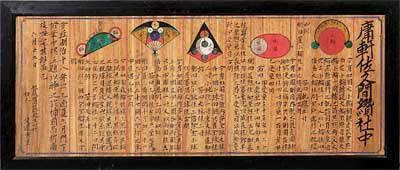Temple Geometry
by Andrew Boyd
Today, temple geometry. The University of Houston's College of Engineering presents this series about the machines that make our civilization run, and the people whose ingenuity created them.
Imagine walking into a church, looking up at the walls, and seeing … math problems. Not stained glass or statues, but wooden tablets inscribed with intricate geometry problems. That was the case for hundreds of years in Japan.

Temple Geometry arose in the seventeenth century during Japan's Edo period. It was a time of great peace and stability during which Japanese culture flourished.
But it was also a time when the country closed its borders to the outside world. For over two hundred years, Japan developed in seclusion. Calculus, the most transformative concept in the history of mathematics, was unknown to the Japanese. And that profoundly influenced mathematical development. Prior to the seventeen hundreds, mathematics hadn't made much progress in Japan. It wasn't a priority. Doing arithmetic with the Chinese abacus was the state of the art. But that changed during the Edo period. A pay-as-you-go school system evolved, open to people from all social classes. People wanted to learn, and they were willing to pay for the luxury. And as education blossomed, so, too, did creativity.
Temple geometry grew out of a fascination with plane geometry; problems involving squares, circles, and other two dimensional shapes. Plane geometry is filled with delightful results. Many are relatively simple, but others are quite involved. And during the Edo period, when people discovered a new geometric truth, they'd engrave it on a tablet and use it to adorn a shrine or temple.
The tablets, called sangaku, bore geometrical figures, problem descriptions, and final answers — but rarely a solution. Visitors to a house of worship were thus invited to ponder where the answer came from. Historians describe sangaku as being "simultaneously works of art, religious offerings, and a record of what we might call 'folk mathematics.'"
Parallels can be found in Western culture. Euclid's Elements, perhaps the most influential book in the history of mathematics, was a study of plane geometry. Mathematics was fundamental to the Pythagoreans' religious mysticism. But Japanese temple geometry was different. It was a mathematical gift to the gods; a thank you for revealing resplendent truths. And a supplication to reveal even greater truths should the gods be so willing.
Today, we study plane geometry in high school. It's an ideal way to teach logical reasoning. And the problems still challenge and satisfy, just as they've done throughout human history. Though I must say, most students don't seem to find it a religious experience.
I'm Andy Boyd at the University of Houston, where we're interested in the way inventive minds work.
(Theme music)
An updated version of this episode can be found at 3111
Fukagawa Hidetoshi and Tony Rothman. Sacred Mathematics. Princeton: Princeton University Press, 2008. Contains information on the history of temple geometry in addition to the solution of many temple geometry problems.
Sangaku: Reflections on the Phenomenon. Taken from the Cut the Knot web site, http://www.cut-the-knot.org/pythagoras/Sangaku.shtml. Accessed December 3, 2008. Contains solutions to many temple geometry problems, some interactive.
The picture of the sangaku tablet is widely circulated and considered in the public domain. It was taken from http://www.princeton.edu/main/news/archive/S15/04/04O77/index.xml?
section=topstories.

An example temple geometry problem. The three circles shown above are tangent to one another and to the horizontal line. Show that the three radii always satisfy the relationship
1/squareroot(R3) = 1/squareroot(R1) + 1/squareroot(R2)
Hint: Use the Pythagorean Theorem on appropriately chosen triangles. For a solution, see http://www.cut-the-knot.org/pythagoras/TangentCirclesSangaku.shtml#solution. Accessed December 3, 2008.